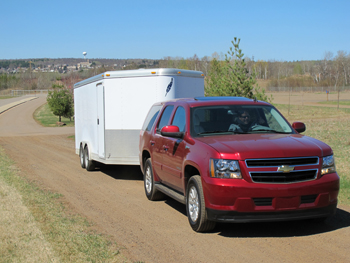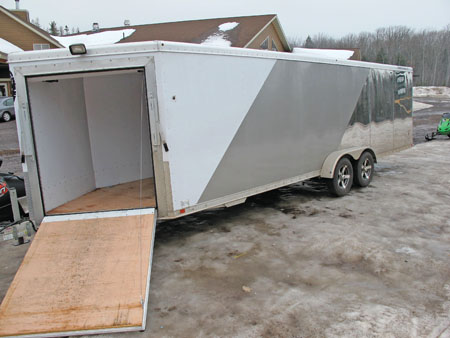 Life is chock full of questions.
Life is chock full of questions.
Should a person go with paper or plastic bags from the grocery store? Was it the chicken or the egg that came first? Did anyone ever figure out who let the dogs out? For snowmobilers, more importantly, what type of trailer yields better fuel mileage from a tow vehicle: an open or enclosed hauler?
After the snow melted last spring — and before we sent our demo sleds back to the factories — we conducted a test and found out that fuel mileage is virtually the same with each trailer. Our truck scored slightly more than 8.5 mpg while towing our Featherlite enclosed trailer. With a four-place Floe open trailer, mileage improved to a little more than 9 mpg.
MPG Factors
While the amount of fuel required to pull each type of trailer was similar in our test, there are other factors to consider if you’re shopping for a way to haul snowmobiles down the road. Each type of trailer has advantages. For an open trailer like the Floe, they typically cost a lot less and offer better rearward visibility. Enclosed trailers are easy to use because covers aren’t necessary and gear can also be hauled inside so there’s more room in the cab of the truck for people to ride comfortably.
An enclosed trailer like the one we used is more aerodynamic because it has flowing lines and a V-shaped nose that cuts through the wind. With an open trailer, air meets the irregular shapes of snowmobiles so the air can’t flow over and around them as easily, presenting more resistance. An open trailer might be preferred in windy conditions, though, because it can get pretty hairy hauling a billboard across wide-open areas with 40 mph crosswinds and icy roads. A trailer like our Floe will catch less wind and is more likely to track straight.
Trailer weight and aerodynamics are factors that affect a tow vehicle’s fuel mileage. Our enclosed trailer (3,350 pounds) weighs almost 2,000 pounds more than the open trailer (1,370 pounds), but the heavier trailer is more aerodynamic. With more weight, that sled hauler takes more fuel to get rolling in start-and-stop traffic, but it cuts through the air more easily on the freeway.
Conversely, a lighter open trailer requires less power to get it rolling, but it has more wind resistance at high speeds, so it may work the truck harder during a long pull down the freeway. If you’re trying to decide whether to go with an open or enclosed trailer, factor the roads and distances into your decision. An open trailer might be a good choice if you travel short distances, while an enclosed might be preferred for long-distance trips with sustained, high-speed driving.
Consistency Is Key
We eliminated as many variables as reasonably possible while towing four sleds on two different trailers. Our 2006 Ford F-250, powered by the V10 gasoline engine with a new air filter, engine oil and oil filter, was the tow rig. All tires were checked and filled to specification before we hit the road. These steps weren’t taken to improve fuel economy, but instead they were to level the playing field by making sure the truck was in good working order so we could get reliable, consistent results towing both trailers.

Trailers used in the test were similar to those used by thousands of snowmobilers across the Snowbelt. One was an 8.5- by 22-foot, Floe aluminum flat bed with a salt shield. The other hauler was a 24-foot Featherlite 1610V enclosed trailer. The 7-foot wide trailer, known as an inline trailer, follows the path cut by the truck. All trailer tires were checked and filled to the air pressure specification listed on the sidewall.
We mapped out a 103-mile route that included a variety of roads that snowmobilers are likely to travel on their way to and from riding destinations. There was a mix of interstate highway, state highway, two-lane county roads out in the country and a few miles of streets through a small, Mississippi River-town’s downtown area.
Our start and end point for this test was the BP gas station in Rogers, Minnesota, a suburb on the edge of the Twin Cities metro area that’s known to Midwestern truckers and travelers for its I-94 truck stop. Our plan was to drive about 10 percent over the posted speed limit — hey, we like to go fast, and we had more work to do! — with smooth acceleration down freeway entrance ramps and from stops. We used cruise control where possible and utilized the same driver for each trailer.
We hooked up and loaded the same four sleds on each trailer at our shop that’s located a few miles south of the filling station, drove to BP to top off the tank and then hit the bricks. After driving the loop, we pulled up to the same gas pump, filled the tank and then calculated the fuel mileage.






